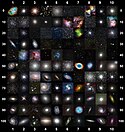25 years of stunning definition Messier 100
After Hubble was launched, the astronomers and engineers operating the telescope found that the images it returned were fuzzy, as if it were out of focus. In fact, that was exactly what was happening. Hubble’s primary mirror functions like a satellite dish; its curved surface reflects all the light falling on it to a single focal point. However, the mirror suffered from a defect known as a spherical aberration, meaning that the light striking the edges of the mirror was not travelling to the same point as the light from the centre. The result was blurry, unfocused images.
To correct this fault, a team of seven astronauts undertook the first Servicing Mission in December 1993. They installed a device named COSTAR (Corrective Optics Space Telescope Axial Replacement) on Hubble, which took account of this flaw of the mirror and allowed the scientific instruments to correct the images they received. The difference between the photos taken of Messier 100 before and after shows the remarkable effect this had, and the dramatic increase in image quality.
COSTAR was in place on Hubble until Servicing Mission 4, by which time all the original instruments had been replaced. All subsequent instrumentation had corrective optics built in.
This new image of Messier 100 taken with Hubble’s Wide Field Camera 3 (WFC3), demonstrates how much better the latest generation of instruments is compared to the ones installed in Hubble after its launch and after Servicing Mission 1.Relevante Bilder
Relevante Artikel
Messier 100Messier 100 = NGC 4321 ist eine aktive Balken-Spiralgalaxie mit ausgedehnten Sternentstehungsgebieten vom Hubble-Typ SBbc im Sternbild Haar der Berenike am Nordsternhimmel. Sie ist schätzungsweise 68 Millionen Lichtjahre von der Milchstraße entfernt. Die Entfernungsmessungen basierend auf den Radialgeschwindigkeiten stimmen nicht mit den rotverschiebungsunabhängigen Entfernungsschätzungen von 53 ± 10 Millionen Lichtjahren überein. .. weiterlesen





